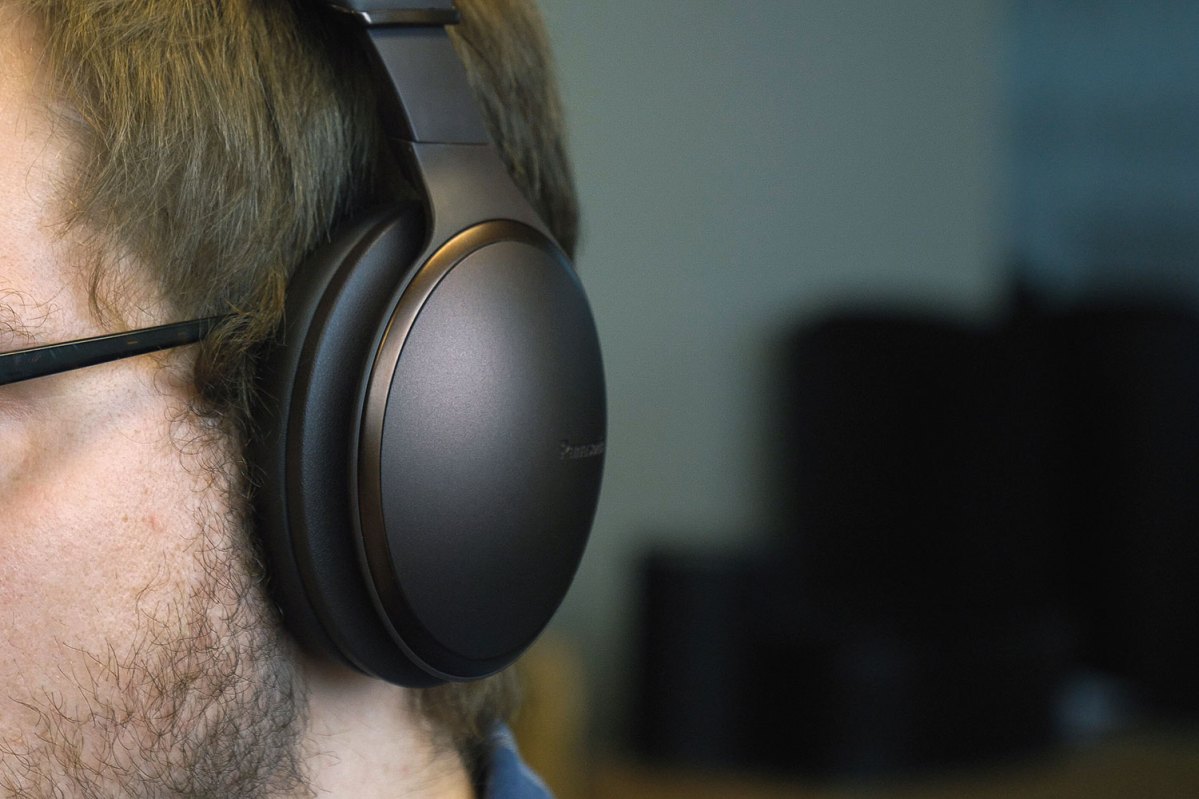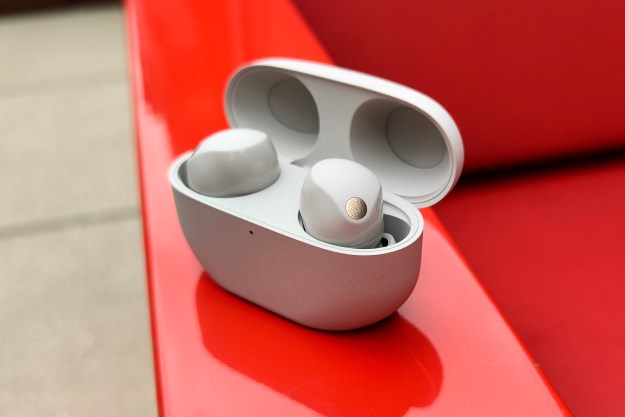
“With impressive sound and great value, Panasonic’s RP-HD605N are the wireless-headphone sleeper hit of 2018.”
- Clear, vibrant sound signature
- Great controls
- Solid noise canceling
- Very comfortable
- Noise-canceling creates distortion in loud environments
- No USB-C
For over a decade, if anyone asked us which noise canceling headphones to buy, we’d direct them to the latest Bose model and tell them there wasn’t a second place. In the past few years, that’s changed. After a long time chasing Bose’s tailpipe, Sony’s scene stealing WH-1000X headphones have actually surpassed Bose’s QC 35 II as our favorite noise cancelers, with others nipping at their heels.
That’s why we were excited to try out Panasonic’s new entrant into the wireless, noise-canceling race. With 20 hours of battery live, compelling features, and the ability to upscale Bluetooth audio with both aptX and LDAC codecs, the Panasonic RP-HD605N more than make up for their cumbersome name. In fact — especially now that they’re available at less than their original $300 list price – they’re one of the best buys you’ll find in the noise-canceling crowd.
Out of the box
The RP-HD605N come folded inside a zippered black carrying case that also houses the included micro USB charging cable, a 3.5 mm cable, and a two-prong airline adaptor for when you’re on an airplane (in 2008).
The cans don’t exactly leap out of the case when it comes to design, and they aren’t supposed to; they sport the same “Middle-aged professional on a business-trip” styling favored by Bose and numerous others in this space. The simple, single-tone over-ears come in two colors: Matte black, and the copper-brown color sported by our review cans. Apart from a Panasonic logo etched on the outside of each earcup, there is very little to draw the eye, which we actually love. We almost always prefer headphones with minimalist design, and the HD605N deliver that in spades.
Features
As opposed to eye-catching flash, the HD605N’s design team clearly put a huge emphasis on comfort. There’s plush leather surrounding the memory foam earcups and headband, and the earcups smoothly adjust on the vertical and horizontal axes to easily conform to the shape of your skull. This makes the HD605N very cozy during long-term listening sessions, where they easily compete with Bose and Sony as the most comfortable headphones we’ve ever worn over extended periods.
The HD605N are among the most comfortable headphones we’ve ever worn.
While the HD605N don’t boast all of the advanced options we’ve seen on wireless over-ears – they won’t auto-pause music when you remove them from your head, for example — they do offer an ample array of appealing features.
As with the Sony WH-1000xM3, you can cup the right earphone to temporarily turn down your tunes and pipe in sound from the outside world, which comes in very handy when you’re trying to order a drink from a passing flight attendant. In fact, there are three total levels of noise canceling to choose from, allowing you to decided just how much of the world around you you’d like to let in.

These settings (and everything else you’ll need to adjust on the headphones), are controlled via a series of buttons on the bottom right earphone. Along with a noise cancelling key, you’ll find a combined on/off and pairing button, and a volume switch/multifunction button. These controls are small but easy to use, with the volume switch/multifunction button coming as a refreshing change of pace from the various convoluted touch controls and tiny-buttons we often see on modern
The headphones easily live up to their promised 20 hours of battery life. They charge via a small micro USB port on the bottom right earphone — we were somewhat surprised that Panasonic’s new flagship wouldn’t have a USB C port for faster charging, but it’s not a deal breaker for us.
Noise canceling
We used the HD605N’s noise canceling extensively in our office, as well as commuting to and from work, and on two cross-country flights. The noise-canceling provides a comfortable, transparent quality we only associate with the best on the market; you really don’t realize just how much they’re doing until you take them off and find yourself assaulted by the sounds of the world around you. We’ll still give both Sony and Bose a slight edge, but the HD605N did a downright stellar job silencing the billowing world around us.
They create a whisper-quiet backdrop over which to paint your most beloved tunes.
In fact, the only time we noticed them struggling to block out external noise was when an airplane’s jet engines were at full throttle during takeoff, when we’d hear a decent amount of distortion, likely from the headphones trying to keep up with the massive influx of noise. Once in the air, that quickly went away, and we were returned to relative silence. It honestly didn’t bother us at all that they had a tough time dealing with such a huge amount of noise temporarily, but it is worth noting.
We typically left them on the highest level of noise canceling, but found that by lowering the level, we could more easily hear announcements in busy airports and on the train to and from work. This will come less in handy for those who mostly plan on wearing them in a noisy office environment, but it’s nice to have at your fingertips when you need it.
Audio performance
As with our other favorite noise canceling options, the HD605N create a whisper-quiet backdrop over which to paint your most beloved tunes. Built-in support for aptX HD and LDAC allows the headphones to present Bluetooth audio with as much fidelity as possible.

The most notable aspect of the HD605N’s sound signature is its meaty punch. It’s not boom-y or warbled on the low end, but everything from the lower-mid frequencies and below has a weight to it that gives pop music and hip-hop a dense base to stand on (pun intended). Artists like Sampha, Kali Uchis, and Jorja Smith all benefit from the headphones’ unique tuning, which makes everything sound crisp and dynamic.
While they are tuned a bit more towards the low end than we usually like, the Panasonic over ears still have a bit less bass than Bose QC 35 II.
Some of our favorite new headphones of 2018.
Treble is bright but not overpowering, offering a clean shimmer that really helps acoustic and electric guitars shine in the mix. We particularly loved listening to Elliott Smith’s XO, with acoustic piano, guitars, and high-pitched harmonies coming through with a fantastic amount of depth and clarity.
In towing the line between the over-colored sound signature offered by Bose and the hyper-flat signature from Sony’s WH-1000xM3, Panasonic finds a good balance that will appeal to many listeners — and suits virtually every genre of music. We still prefer the extreme transparency and gorgeous full frequency response of the past few Sony models overall, but we’d absolutely choose the Panasonic HD605N over the Bose. At $50 lower or more, that’s huge victory for Panasonic.
Warranty information
Panasonic offers a one-year warranty on parts and labor.
Our Take
We can’t think of a pair of active
Is there a better alternative?
If you’ve got deeper pockets, we recommend Sony’s WH-1000xM3. With ten more hours of battery, better noise canceling, and an even more pristine sound signature, they are our favorite headphones on the market. That said, if money is tight, we’d deeply consider purchasing the HD605N over Bose’s (pricier) QC 35 II, and that’s saying something.
How long will it last?
Provided you aren’t an absolute madman and treat your headphones with care, we think the Panasonic RP-HD605N should last for many years of solid use, and with newer Bluetooth codecs in aptX and LDAC they’re also relatively well future proofed.
Should you buy it?
Yes. If you’re in the market for a pair of great-sounding wireless
Editors' Recommendations
- Sony WH-1000XM6: the design and features we want Sony’s next headphones to deliver
- Best Bose 700 deals: Save $151 on the wireless headphones today
- The 11 best noise-canceling headphones for 2024
- Sennheiser Accentum Plus aims at the middle ground between budget and baller
- JBL upgrades its 2024 wireless headphones with massive battery life









